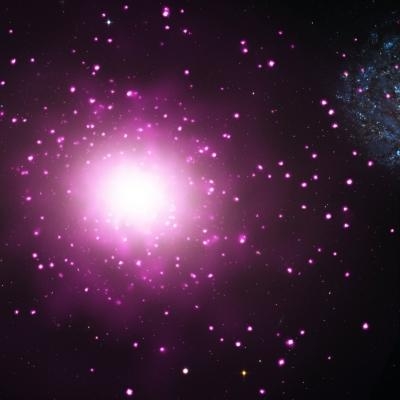Tue, Oct 01, 2013
Half The Galaxy's Mass Is Concentrated Over 80 Light Years
Astronomers using NASA's Hubble Space Telescope and Chandra X-ray Observatory and telescopes on the ground may have found the most crowded galaxy in our part of the universe. The ultra-compact dwarf galaxy, known as M60-UCD1, is packed with an extraordinary number of stars and may be the densest galaxy near Earth. It is providing astronomers with clues to its intriguing past and its role in the galactic evolutionary chain.

M60-UCD1, estimated to be about 10 billion years old, is near the massive elliptical galaxy NGC 4649, also called M60, about 54 million light years from Earth. It is the most luminous known galaxy of its type and one of the most massive, weighing 200 million times more than our sun, based on observations with the W.M. Keck Observatory 10-meter telescope in Hawaii. What makes M60-UCD1 so remarkable is that about half of this mass is found within a radius of only about 80 light years. The density of stars is about 15,000 times greater -- meaning the stars are about 25 times closer to each other -- than in Earth's neighborhood in the Milky Way galaxy. "Traveling from one star to another would be a lot easier in M60-UCD1 than it is in our galaxy, but it would still take hundreds of years using present technology," said Jay Strader of Michigan State University in Lansing. Strader is the lead author of a paper about the research, which was published Sept. 20 in The Astrophysical Journal Letters.
The 6.5-meter Multiple Mirror Telescope in Arizona was used to study the amount of elements heavier than hydrogen and helium in stars in M60-UCD1. The values were found to be similar to our sun. "The abundance of heavy elements in this galaxy makes it a fertile environment for planets and, potentially, for life to form," said co-author Anil Seth of the University of Utah. Another intriguing aspect of M60-UCD1 is the presence of a bright X-ray source in its center, revealed in Chandra data. One explanation for this source is a giant black hole weighing in at about 10 million times the mass of our sun.
Astronomers want to find out whether M60-UCD1 was born as a jam-packed star cluster or became more compact as stars were ripped away from it. Large black holes are not found in star clusters, so if the X-ray source is in fact due to a massive black hole, it was likely produced by collisions between M60-UCD1 and one or more nearby galaxies. M60-UCD1's great mass and the abundances of elements heavier than hydrogen and helium are also arguments for the theory it is the remnant of a much larger galaxy. "We think nearly all of the stars have been pulled away from the exterior of what once was a much bigger galaxy," said co-author Duncan Forbes of Swinburne University in Australia. "This leaves behind just the very dense nucleus of the former galaxy, and an overly massive black hole."
If this stripping did occur, then the galaxy originally was 50 to 200 times more massive than it is now, and the mass of its black hole relative to the original mass of the galaxy would be more like that of the Milky Way and many other galaxies. The stripping could have taken place long ago and M60-UCD1 may have been stalled at its current size for several billion years.
(Image provided by NASA)
More News
Omnidirectional Approach Lighting System ODALS consists of seven omnidirectional flashing lights located in the approach area of a nonprecision runway. Five lights are located on t>[...]
"Polaris Dawn, the first of the program’s three human spaceflight missions, is targeted to launch to orbit no earlier than summer 2024. During the five-day mission, the crew >[...]
Also: 1800th E-Jet, Uncle Sam Sues For Landing Gear, Embraer Ag Plane, Textron Parts A friend of the family reported that Lt. Col. (Ret.) Richard Glenn Rutan flew west on Friday, M>[...]
Also: Virgin Galactic, B-29 Doc to Allentown, Erickson Fire-Fighters Bought, FAA Reauthorization After dealing with a big letdown after the unexpected decision by Skyreach to disco>[...]
“Our aircrews are trained and capable of rapidly shifting from operational missions to humanitarian roles. We planned to demonstrate how we, and our BORSTAR partners, respond>[...]
 ANN's Daily Aero-Term (05.05.24): Omnidirectional Approach Lighting System
ANN's Daily Aero-Term (05.05.24): Omnidirectional Approach Lighting System Aero-News: Quote of the Day (05.05.24)
Aero-News: Quote of the Day (05.05.24) Airborne 05.06.24: Gone West-Dick Rutan, ICON BK Update, SpaceX EVA Suit
Airborne 05.06.24: Gone West-Dick Rutan, ICON BK Update, SpaceX EVA Suit Airborne 05.03.24: Advanced Powerplant Solutions, PRA Runway Woes, Drone Racing
Airborne 05.03.24: Advanced Powerplant Solutions, PRA Runway Woes, Drone Racing Aero-News: Quote of the Day (05.06xx.24)
Aero-News: Quote of the Day (05.06xx.24)



